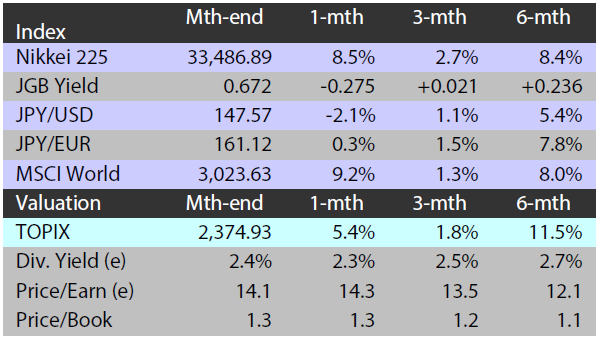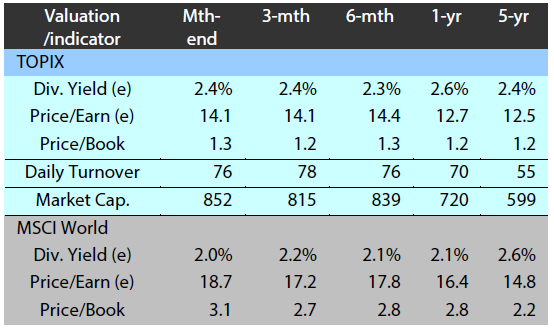Low political expectations help market brush aside Japan’s ruling party scandal
Japanese equities have started 2024 on the front foot, with the Nikkei Stock Average rising to a 34-year high early in January. The market’s steady performance comes despite a political scandal—described by some media outlets as the biggest in decades—shaking Japan’s ruling Liberal Democratic Party (LDP) and threatening Prime Minister Fumio Kishida’s administration. Over the past few months numerous lawmakers belonging to the LDP’s powerful Abe faction, named after the late Prime Minister Shinzo Abe, have been accused of underreporting and hiding funds procured at fundraisers. The scandal has resulted in the resignation of four cabinet ministers and public support for Kishida has plummeted, although he does not belong to the Abe faction.
Generally speaking, the higher the support rating is for an administration the better because it can enact policies—which usually include measures friendly to the economy and the markets—with greater ease. In the case of Kishida, however, his sagging ratings are not having much of an effect so far given that the market greeted the start of his administration with low political expectations. In what was dubbed the “Kishida shock”, the Nikkei slid when Kishida took office in 2021 on initial wariness over the new premier’s “new capitalism” initiative. Equities did eventually bounce back but the recovery can be attributed in large part to factors other than the policies the Kishida administration has opted to pursue. Leaders with positive responses from the market are in fact a rarity; of the prime ministers in recent memory, only Abe and Junichiro Koizumi may be said to fall into this category.
A potential concern for some is that the scandal is weakening the influence of the Abe faction, and by extension the spirit of Abenomics—a set of policies which many credit for helping Japan recover from years of stagnation when it was introduced more than a decade ago. Abenomics was based on three main policy pillars: easing by the Bank of Japan (BOJ), fiscal stimulus, and deregulation. The reality is that history is moving beyond Abenomics. Monetary policy is one example of this. When Abe took office, the BOJ was tasked with ending deflation and bringing inflation to 2%. However, inflation has since risen above 2%, and the focus of monetary policy has been shifted to whether inflation can remain above the threshold for a sustained period. If Abe was still at the head of his faction (he was assassinated in 2022), he likely would have approved of the BOJ mulling an exit from unorthodox monetary easing policies, including negative interest rates.
As for fiscal stimulus, the second policy pillar, Kishida has pursued initiatives that are distinctly his own and seemingly independent of influences from the Abe faction. These include revamping the Nippon Individual Savings Account (NISA) and increasing government support in fields such as the space industry and artificial intelligence. With the third policy pillar, the Kishida administration has forged a unique path with its attempts to further digitise the economy through deregulation, although for the most part it appears to have picked up where preceding administrations left off.
2024 a potential inflection point in Japan’s “savings to investments” drive
For more than two decades, Japan has been trying to encourage households to shift their vast financial assets, which are estimated at around Japanese yen (JPY) 2,100 trillion, into investments, but with limited success. Having inherited the “savings to investments” banner, the Kishida administration’s trump card is the above-mentioned revamped NISA. Starting in 2024, maximum investment amounts allowed under NISA have been increased and investors can enjoy the system’s tax benefits permanently (the tax-free period was previously set at a maximum of 20 years). These changes to NISA, in theory at least, are expected to encourage Japanese households to begin channelling their savings in the form of cash and deposits, which represent roughly half of the JPY 2,100 trillion of financial assets they hold, into investments.
While news headlines have touted Japan’s shift from deflation to inflation as an incentive for households to begin investing in riskier assets such as stocks via NISA, such moves would be primarily motivated by anxiety over rising prices and are unlikely to be a decisive factor in the long term. What is needed for individuals to turn into long-term investors is an accumulation of success. Many individual investors in their 30s have likely experienced gains by investing a few years ago in Chinese and US stocks and tasted further success with Japanese equities in 2023, which rose to three-decade highs that year. With the 2023 bull run by Japanese equities still fresh in memory, the revamped NISA could become a gateway for individuals to invest in stocks. The steady rise in wages and higher bonuses witnessed recently could also provide an incentive for individuals to invest. In that respect, 2024 could become an inflection point in Japan’s savings to investments drive.
It is up to private sector institutions to effectively communicate with individuals about the new opportunities offered by NISA now that the government has done its part. However, there is still more the government can do within the savings to investments initiative. For example, it can heed calls to broaden the scope of Japan’s defined contribution (DC) pension plans. Examples in the US and Europe have shown that DC plans with greater scope for investments and default strategies linked to equity investments can be successful. Introducing such features to Japan’s DC plans may have a more significant impact on the market in the long term than the latest NISA revisions.
Market: Japan stocks mixed in December as strong yen weighs but strong global equities provide support
The Japanese equity market was mixed in December, with the TOPIX (w/dividends) dipping 0.23% on-month and the Nikkei 225 (w/dividends) edging up 0.09%. US equities gained following the conclusion of the December Federal Open Market Committee (FOMC) which gave rise to expectations that the US Federal Reserve (Fed) would slash rates in 2024. At the same time, the BOJ left its accommodative monetary policy unchanged at its Monetary Policy Meeting. While such trends supported Japanese equities, other factors weighed down share prices, including a shrinking gap between interest rates in the US and Japan arising from the outlook for the Fed to end its rate hikes and the appreciation of the yen against the US dollar.
Of the 33 Tokyo Stock Exchange sectors, 14 sectors rose, with Marine Transportation, Services, and Chemicals posting the strongest gains. In contrast, 19 sectors declined, including Mining, Transportation Equipment, and Rubber Products.
Exhibit 1: Major indices
 Source: Bloomberg, 29 December 2023
Source: Bloomberg, 29 December 2023
Exhibit 2: Valuation and indicators
 Source: Bloomberg, 29 December 2023
Source: Bloomberg, 29 December 2023



